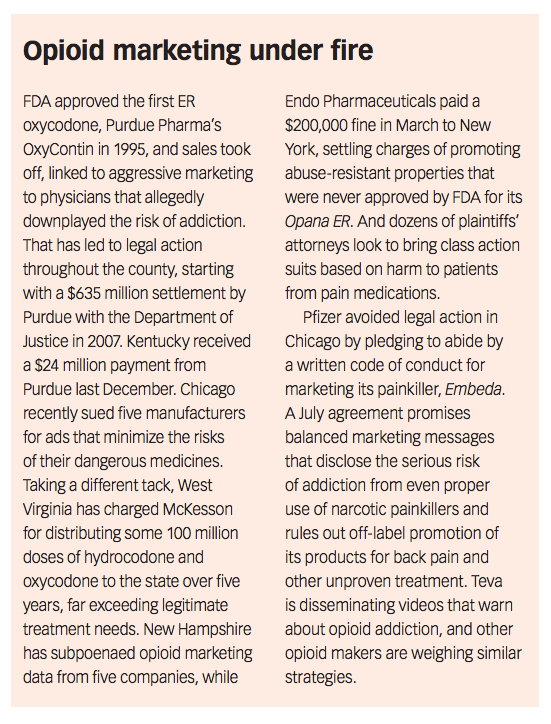Opioid Epidemic Prompts More Finger Pointing at Pharma
Pharmaceutical Executive
Traditional sales and pricing practices face legal challenges and political backlash.
One issue that Democrats and Republicans agree on is that too many Americans are dying or becoming addicted to powerful prescription pain medications, and that the government, the medical profession and the pharmaceutical industry need new strategies to halt the spread of opioid abuse across the nation. States are suing pharma companies for misleading promotional messages, while members of Congress complain
Jill Wechsler

about high prices for antidotes and for safer formulations. Politicians of all stripes demand limits on opioid prescribing and dispensing and more treatment for addicts.
An estimated 19,000 Americans died last year from prescription opioid overdoses, and thousands end up in emergency rooms every day, largely related to over-use and abuse of extended release/long-acting (ER/LA) pain medications. While these drugs provide much-needed relief to individuals suffering from chronic pain, they also can provide a big “high” when crushed so they can be inhaled or injected. Huge sales increases over the past decade indicate opioid use far greater than what is needed for legitimate patient treatment.
Prices and access
FDA is working to improve access to pain medicines that resist abuse, as well as non-opioid alternatives and “rescue” treatments such as naloxone to counter overdoses. The agency has approved six drugs with abuse-resistant formulations (ADFs) since 2011, and in August added Pfizer’s Troxyca ER to the list. Guidance finalized in April 2015 advises sponsors on ADF testing and labeling, which has helped spur development of innovative products with technologies that are harder to crush or that counter the opioid effect. While such therapies may help reduce opioid abuse, they are expensive to develop and manufacture and thus carry higher prices.
Payers and patients may accept more expensive pain medicines if they also help reduce health spending. A recent report by nonprofit FAIR Health documents how heavy opioid users incur high-cost medical services, rocketing up outlays in this area 3,000% from 2007 to 2014. A study published in the April Journal of Managed Care & Specialty Pharmacy agrees that the ADFs can reduce healthcare and medical expenditures, but also found that higher prices for these innovative formulations offset most of the savings. One response is to support development of generic ADFs to inject competition into the ER opioid market, similar to the situation with immediate-release pain meds, which are largely generic. To this end, FDA issued draft guidance in March advising sponsors on developing, testing and documenting similarity of generic opioids with ADF features. The agency will discuss its approach at a public meeting on Oct. 31 and Nov. 1, even though low-cost ADFs may not appear any time soon due to patent protections for the new meds that won’t expire for years.

There’s also concern about high prices and shortages of naloxone. This newly-important “rescue” therapy has been cheap and widely available in the past, but now more scarce as generics makers have exited the market, leaving Pfizer’s Hospira and Mylan the main producers of this sterile injectable. Meanwhile, new intranasal naloxone products and an auto-injector version have made the drug easier to use, but also more expensive.
Concerns about affordability and access have been raised by the Centers for Disease Control and Prevention (CDC) and Senate leaders. A main thrust of the Comprehensive Addiction and Recovery Act (CARA), signed by President Obama in July, is to support state and local programs that provide access to naloxone and other opioid alternatives. CARA lacks funding, but bolsters pain management for veterans and prescription drug monitoring programs in most states that identify high-prescribing practitioners and heavy opioid users. It also removed a Medicaid policy that set higher rebates on “line extension” drugs, which stood to discourage development of generic ADFs.
Payers step in
The prospect of cutting costs, while also preventing death and patient harm, is prompting insurers and health plans to do more to reduce opioid prescribing. BlueCross BlueShield of Massachusetts, for example, requires prior authorization for new LA opioid prescriptions and refills beyond 30 days, authorizes pain management programs for heavy users, and seeks improved communication with physicians to prevent “doctor shopping.”
Aetna has identified nearly 1,000 “super-prescriber” doctors who refill prescriptions for painkillers at unusually high rates-not including oncologists and pain specialists who normally handle high volumes of serious cases. The insurer isn’t taking action against individual physicians or implying fraud, acknowledging that some heavy prescribing is perfectly legitimate. But it hopes to steer practitioners to guidelines issued by the

CDC that encourage greater use of non-opioid painkillers, set criteria for starting and stopping prescriptions and highlight the potential harm of multiple refills. Medicare also seeks to address the rise in opioid prescribing by Part D drug plans. A June 2016 report from the HHS Office of the Inspector General (OIG) found that spending on opioids exceeded $4 billion in 2015, up 165% from 2006 to 2015. The OIG wants more reporting of potential fraud and abuse by plans and limits on pharmacies and prescribers for certain beneficiaries.
Initiatives to reduce inappropriate prescribing emphasize the importance of better educating physicians in proper pain management and prescription drug abuse treatment. FDA instructed manufacturers to provide such programs to medical professionals under a risk evaluation and mitigation strategy (REMS) established in 2012. But relatively few prescribers have completed available courses, prompting calls for a mandatory educational effort. If that fails, tighter controls on pain med distribution could emerge-which won’t please doctors or manufacturers.
Physicians prefer a policy proposal to drop or modify queries about pain treatment in patient satisfaction surveys of hospital and doctor quality of care. The thinking is that such questions put pressure on doctors to prescribe powerful painkillers to achieve high ratings.
Jill Wechsler is Pharmaceutical Executive’s Washington correspondent. She can be reached at jill.wechsler@ubm.com

Pfizer, GSK Gain ACIP Recommendations for RSV and Meningococcal Vaccines
April 18th 2025The Centers for Disease Control and Prevention’s Advisory Committee on Immunization Practices voted to expand access to Pfizer’s respiratory syncytial virus vaccine Abrysvo for high-risk adults in their 50s and voted in favor of GSK’s meningococcal vaccine, Penmenvy, for streamlined adolescent protection.
Navigating Distrust: Pharma in the Age of Social Media
February 18th 2025Ian Baer, Founder and CEO of Sooth, discusses how the growing distrust in social media will impact industry marketing strategies and the relationships between pharmaceutical companies and the patients they aim to serve. He also explains dark social, how to combat misinformation, closing the trust gap, and more.